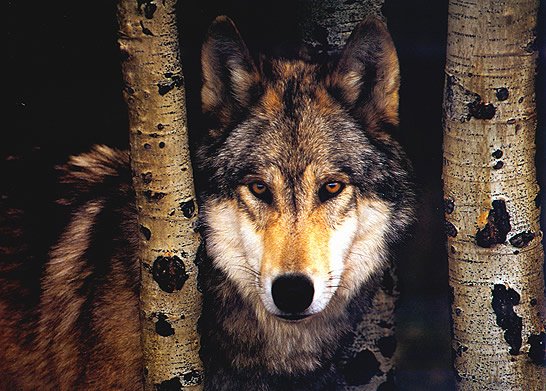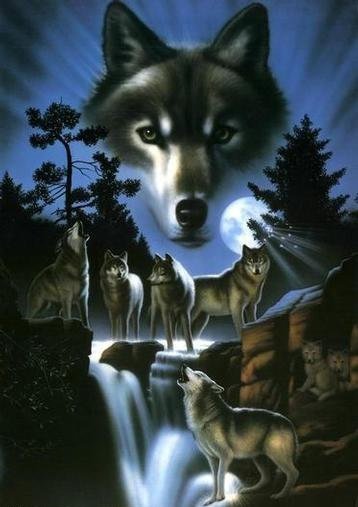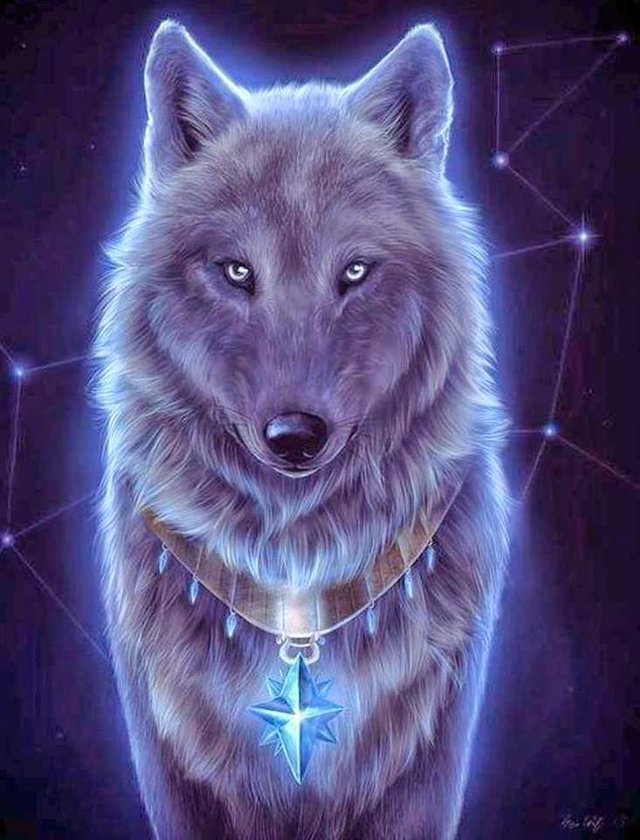All about wolves


 Wolf or Gray Wolf (Canis lupus) is the largest wild member of the canidae family. It is a survivor of the Ice Age originating during the Pleistocene Superior, about 300,000 years ago. DNA sequencing and genetic studies reaffirm that the gray wolf has a common ancestry with the domestic dog (Canis lupus familiaris). Although some aspects of this statement have been questioned recently. [3] A number of other subspecies of the gray wolf have been identified, although the actual number of subspecies is still under discussion. Gray wolves are typically apex predators in the ecosystems they occupy. Although the human presence is not as adaptable as the more general canid species, [3] the wolves have developed in temperate forests, deserts, mountains, tundras, taiga, fields and even in some urban areas. The wolf as well as the red wolf (Canis rufus) are the two official species of wolves, the others are considered subspecies.
Wolf or Gray Wolf (Canis lupus) is the largest wild member of the canidae family. It is a survivor of the Ice Age originating during the Pleistocene Superior, about 300,000 years ago. DNA sequencing and genetic studies reaffirm that the gray wolf has a common ancestry with the domestic dog (Canis lupus familiaris). Although some aspects of this statement have been questioned recently. [3] A number of other subspecies of the gray wolf have been identified, although the actual number of subspecies is still under discussion. Gray wolves are typically apex predators in the ecosystems they occupy. Although the human presence is not as adaptable as the more general canid species, [3] the wolves have developed in temperate forests, deserts, mountains, tundras, taiga, fields and even in some urban areas. The wolf as well as the red wolf (Canis rufus) are the two official species of wolves, the others are considered subspecies.
1 Features
1.1 Reproduction and life cycle
1.2 Diseases
2 Distribution map
3 See also
4 External links
Characteristics
The weight and size of wolves can vary widely across the world, tending to increase proportionately with latitude, as predicted by Christian Bergmann's theory. In general, the height ranges from 60 to 95 centimeters if measured from the shoulder. The weight varies geographically, on average, European wolves can weigh 38.5 kg, North American wolves 36 kg, Indian wolves and 25 kg arabs. Although they have rarely found wolves with more than 77 kg registered in Alaska, Canada, [7] and in the former Soviet Union. The heavier gray wolf registered in North America was killed at 70 Mile River in east central Alaska on July 12, 1939 and weighed 79 kg, [6] while the heaviest wolf registered in Europe was killed after World War II in the Kobelyakski area of the Poltavskij region in the Ukrainian RSS and weighed 86 kg. The wolf is sexually dimorphic, females in any typical wolf population typically weigh 20% less than males. [10] Females also have the narrowest snout and forehead; Slightly shorter, straight leg hair and less massive shoulders. [6] The gray wolves can measure from 1 to 2 meters from the muzzle to the tip of the tail, which in itself represents about 1/4 of the total length of the body. Skeleton of a gray wolf.
They are able to travel several long distances at about 10 kilometers per hour and are known to reach speeds close to 65 kilometers per hour during a chase. A wolf-cinzanta was recorded for having made jumps of 7 meters when chasing prey. The claws of the front legs are larger than the hind legs, where there is a fifth finger that is absent on the hind legs. The wolf's legs are able to tread easily on a variety of terrains, especially in the snow. There is a layer of skin between each finger, which allows them to move on the snow more easily than compared to the impaired prey. Gray wolves are digitized, which with the relative greatness of their paws helps to distribute their weight well on snowy surfaces. Hair and nails strengthen grip on slippery surfaces and special blood vessels keep the legs warm from freezing. [14] Odoriferous glands located between the toes of a wolf leave traces of chemical markers behind, helping the wolf to walk effectively over large tracts while simultaneously keeping others informed of its whereabouts. Unlike western dogs and coyotes, gray wolves have a lower density of sweat glands on their paws. This feature is also present in the Eastern Canadian coyotes that were shown to have ancestry with the recent wolf. Wolves in Israel are unique due to the average two toes of their paws being cast, a trait originally thought to be unique to the African wild dog.
A gray-brown wolf
Wolves have bulky hairs consisting of two layers. The first coat is made of sturdy hair that repels water and dirt. The second is a dense, water-resistant coat that insulates it. The undercoat is spread throughout the body in the form of large tufts of hair in late spring or early summer (with annual variations). A wolf will often rub against objects such as rocks and twigs to encourage loose fur. The undercoat is usually gray, regardless of the appearance of the outer coat. Wolves have distinct pelages in winter and summer that alternate in the spring and fall. Females tend to keep their hair from winter to spring as well as males.
The color of the coat varies widely, ranging from gray to brownish gray, all formed through the spectrum of white, red, brown and black canine. These colors tend to blend into many populations so that the individuals most predominantly are the majority, but it is not uncommon for an individual or a whole population of wolves to be entirely one color (usually all black or all white). With the exception of Italy, where black wolves can account for between 20% and 25% of the entire population, melanistic wolves are rarely common outside the North American continent. According to genetic testing, the color of the black coat is based on a mutation that first appeared among domestic dogs and later migrated to the population of the wolves through crosses. A multicolor coat, characteristically, has no specific pattern that does not tend to be lighter on the underside of the animal. The color of the skin sometimes corresponds to an environment given the population of wolves, for example, all white wolves are much more common in areas with snow cover. Aging wolves turn gray in their coat. It is often thought that the coloring of the wolf coat serves as a functional form of camurflage. This may not be entirely correct, as some scientists have concluded that the combined colors have more to do with emphasizing certain gestures during interaction. Gold-yellow eyes are common in adolescent wolves.
At birth, wolf pups tend to have darker hairs and the iris of blue eyes will change to a yellow-gold, or orange when the puppies are between 8 and 16 weeks of age. Wolves with powerful long muzzles help them to distinguish them from other canids, named coyotes and golden jackals, which have the narrowest and pointed muzzles. In wolves, the anterior notch of the nasal bone does not have a medial overhang, unlike jackals. The cingulate at the outer edge of the upper first molar is only slightly expressive, while it is broad and clearly striking in jackals.
Wolves differ from domestic dogs in a more varied nature. Anatomically, wolves have smaller orbital angles than dogs (over 53 degrees for dogs, less than 45 degrees for wolves) and comparatively larger brain capacity. [21] Larger paws, yellowish eyes, longer legs and larger teeth still distinguish adult wolves from other canids, especially dogs. In addition, a supracaudal gland is present at the base of the tail of the wolves, but not in many dogs.
Larger wolves and dogs have some identical dentition parts. The maxilla has six incisors, two canines, eight premolars and four molars. The mandible has six incisors, two canines, eight premolars and six molars. [22] The fourth premolars and mandibular first molars are carnivorous teeth, which are essential tools for cutting the meat. Canine teeth are also very important in that they hold and subjugate the prey. Capable of carrying up to 10,000 kilopascal of pressure, the teeth of a wolf are its main weapons, as well as its main tools. That is roughly twice the pressure that a similarly sized domestic dog can provide. [23] The dentition of the gray wolves is more suitable to crush bones than the other modern canines, although not as specialized as the one found in hyenas. Saliva from wolves has been shown to reduce bacterial infection in wounds and to accelerate tissue regeneration. [25]
Reproduction and life cycle
Generally, mating occurs between the months of January and April, the greater the latitude, the later it occurs. [26] A pack usually produces a single brood except for male breeding partners with one or more subordinate females. During the mating season, the breeding wolves become very affectionate with each other in anticipation of the ovulation cycle of the female. Tension increases as each pack of mature wolves feels encouraged to mate. During this time, the double-breeding leader may be forced to prevent other wolves from mating with each other. [27] Incestos rarely occur, although depression due to inbreeding has been reported to be a problem for wolves in Saskatchewan [28] and Isle Royale. [29] When the reproductive female enters estrus (which occurs once a year and lasts 5-14 days), [30] she and her partner spend a long time in seclusion. Pheromones in the urine of the female and the swelling of her vulva make known to the male who is in heat. The female is receptive in the early days of estrus, during which time she casts the lining of the uterus, but when she begins to ovulate again, mating occurs with the partner. A wolf cub in his mother's company
The gestation period lasts between 60 and 63 days. The puppies, weighing about 0.5 kg at birth, are blind, deaf and completely dependent on their mothers. [26] [31] The average brood size is 5-6 pups, although there are two Soviet records of litters with 17 pups. [9] The cubs reside in the pit and remain there for two months. The burrow is usually on high ground near an open water source, and has an open chamber at the end of an underground tunnel or slope that can be up to a few meters long. During this time the pups become more independent and end up starting to explore the area immediately outside the pit before gradually wandering up to a kilometer away from it at about five weeks of age. The growth rate of wolves is slower than that of coyotes and wild dogs. [32] They begin to eat regurgitated food after two weeks of feeding on milk, which in wolves has less fat and arginine and more protein than canine milk. [10] By this time, their milk teeth come up and they are fully weaned after 10 weeks. During the first weeks of development, the mother usually stays with her litter alone, but eventually most of the group members contribute to the rearing of the pups in some way. [26] After two months, the restless puppies are taken to a meeting place where they can remain safely when most adults go out to hunt. One or two adults are left behind to ensure the safety of the puppies. After a few more weeks, puppies are allowed to join the adults if they are able, and will have priority over any hunted animal. Leaving the chicks hunt to eat privileges of the results in a secondary ranking being formed between them, and allows them to practice the domination / submission rituals that will be essential for their future survival in the life of the pack. During the hunt, the pups remain observant until they reach about eight months of age, at which time they are large enough to actively participate.
Wolves usually reach sexual maturity after two or three years, when many of them will be forced to leave their places of birth and seek companions and territories of their own. Wolves that reach maturity usually live from six to ten years in the jungle, although in captivity they can live up to twice the age. High mortality rates give them a low overall life expectancy. The offspring die when food is scarce, as they may also be targets of predators such as bears, tigers, adult wolves or other animal seals. The most significant causes of mortality for the wolves are the cultivated hunting and fishing, car accidents and injuries during hunting. Although adult wolves may occasionally be killed by other predators, rival wolf groups are often the most dangerous nonhuman enemies.
Diseases The Arabian wolf's posture and facial expression is defensive and warns the other wolves to be wary.
The most common diseases carried by wolves include brucellosis, fever, leptospirosis, foot-and-mouth disease and carbuncle. Wolves are great hosts of rage in Russia, Iran, Afghanistan, Iraq and India. [35] Although wolves are not reservoirs of the disease, they can pick up from other species. The wolves have developed an extremely serious and aggressive state, when enraged they can bite several people in a single attack. Before a vaccine is developed, bites are almost always fatal. Today, biting rabid wolves can be treated, but the severity of angry wolf attacks can sometimes result in death, or a bite near the head will cause the disease to act too fast for treatment to take effect. Rabid attacks tend to clump in the winter and spring. With the reduction of rabies in Europe and North America, few attacks of rabid wolves have been recorded, although some still occur annually in the Middle East. Wolves also carry canine coronavirus, with infections being more prevalent in the winter months. [37]
Registered wolves in Russia carried more than 50 different types of harmful parasites, including echinococcus, cysticercosis, and coenuri. [35] Wolves are also carriers of trichinella spiralis. Between 1993-94, 148 carcases of wolves near Fairbanks in Alaska were examined and 36% (approximately 54 carcases) were infected. The prevalence of trichinella spiralis in wolves is significantly related to age. [38] Wolves can carry neospora caninum, which is of particular interest to farmers, as the disease can be transmitted to domestic animals, in infected animals is 3 to 13 times more likely to miscarry than those who are not infected. [39]
Despite the habit of carrying dangerous diseases, large populations of wolves are not heavily regulated by outbreaks of epizootics as is the case with other social canids. This is mainly due to the habit of infected wolves vacating their packs, thus preventing mass contagion.